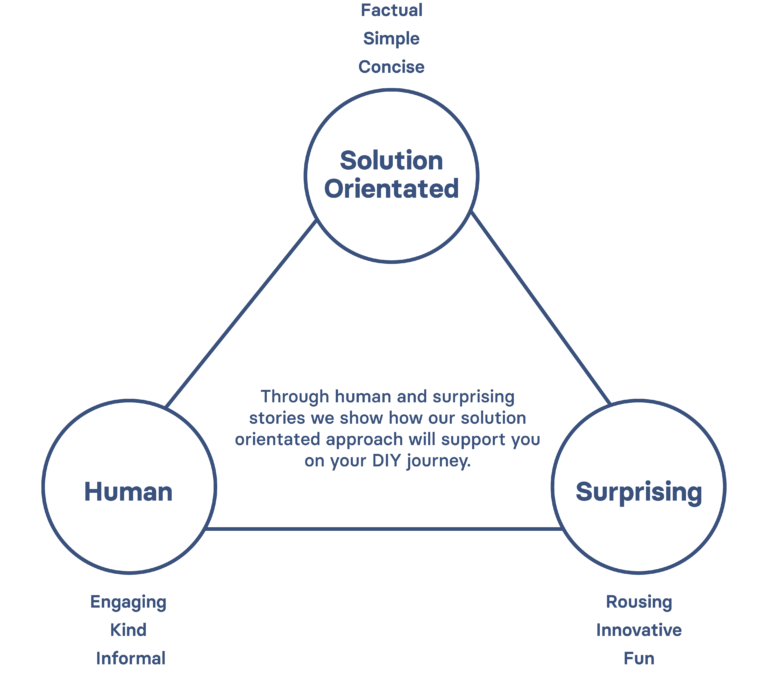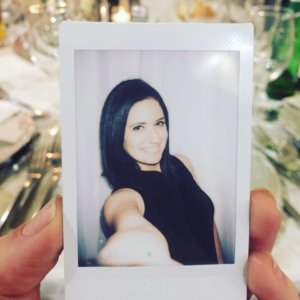Hey! How are ya? Some days I’m a ray of bloody sunshine. Other days, less so. But ultimately, while I might be Grumpasaurous Rex on Monday and Miss Congeniality on Tuesday, I’m still the same person at my core: sassy, sharp, and, even on my lowest days, optimistic.
Your brand’s the same. No, I’m not suggesting that you go ranting online when you’re in a mood (please don’t), but while the things that you’re talking about change, the world around you is clearly not stock standard, and the people you’re talking to will vary – at your core, your brand remains the same, too.
In my last article, which you kinda need to read for this whole process to make sense (click here to read if you haven’t!), we discussed finding the central purpose of your brand and distilling it down to THE ONE WORD. Now, we’re going to build on that word to create the facets of your brand personality.
Just a spoonful of personality helps the medicine go down.
Why does brand personality matter? Well, it’s the same as human personality. A human/brand with an interesting personality is memorable. A human/brand with a relatively consistent personality is believable. A human/brand with a personality that “gets you” is relatable.
Who doesn’t want themself or their brand to be memorable, believable, and relatable? This is how you get people to like you. And when you’re liked, you get away with making mistakes, you get away with pushing product, you get away with being a brand invading Social Media, which is meant to be a space for friends.
Same, same – but different.
I once (note the past tense) followed an eyelash studio on Instagram. I wanted to book them for my wedding, so I emailed them. The person who replied to my mail was so short with me and gave me one word answers to my questions. This was one of the most exciting times of my life, and they seemed disinterested in me (and my money). They weren’t the same positive, caring, thoughtful soul who I’d come to “know” on Insta. I didn’t book them. Later I found out that the owner had asked someone to help her with admin. I was glad to hear that her business was busy enough to need an assistant, but then that assistant needs to understand the brand tone.
This is something many businesses tend to forget. When you as the owner go on this communication journey, you need to make sure that everyone who interacts with your customers, online and in the real-world, is on the journey with you. I do workshops with clients and their teams to make sure that this sort of communication #fail doesn’t happen, but as long as you keep your staff up-to-date, that’s a great start.
Social Media is a beast. It’s hard work. That’s why the people who can do it for you get paid lots of money. The thing is, those who do it well are not doing it on the fly. It takes time, effort, resources, thinking and a lot of skill. So close Facebook. Log out of Instagram. Say toodles to Twitter. Today, we’re not talking about what you should be saying on Social Media. We’re talking about WHY you’re saying it.
Let’s build thatpersonality.
Going back my house-building metaphor and the friendly neighbourhood Hardware Store again (see, you need to read the first article). First, we looked at the competitors, the audience groups, and their needs. We laid the foundation of the metaphorical house and decided that the central purpose of the Hardware Store is SUPPORT. This is the WHY. It’s why you exist as a brand: to support your audiences on their DIY journeys.
At the end of the article, I asked: “How do you build on top of this foundation?” This is your HOW. Your personality is HOW you communicate with your audience to bring the WHY to life. (As opposed to your WHAT, which is what you are saying). This is the structure of your house. Is it a quirky cottage? A serious mansion? A mysterious batcave?
Audience. Audience. Audience.
To determine the appropriate personality type, we don’t suck it out of thin air. We go back to your audience, because at the end of the day, they’re the ones who we want to like you.
Here’s the audience example set I looked at last, remember, I mentioned that you can end up with 5 or 10 or 15 or more Audience Groups and we must find ways to connect with all of them (there are more examples back in article numero uno). So, looking at these audience groups, what do and don’t they want to feel, considering the needs that we’d discovered?
DIY Newbies
People who don’t really know what they’re doing, but they are
inspired to get started.
- Unsure where to begin.
- Unsure who to turn to.
- Unsure who to trust.
- Find DIY intimidating.
- Life’s expensive, don’t want to waste money.
- Inspired by Social Media.
- Want to create a beautiful life.
- Etc.
DIY Pros
These are professionals. The painters, plumbers, electricians, etc. who need tools for their jobs.
- Life and paying the bills is increasingly stressful.
- Want to be valued.
- In a competitive industry, rely on word of mouth.
- They want to show off what they do for their clients, as it will get them more work.
- Want to create a beautiful life for their clients.
- Etc.
Supported through their DIY journey. Not made to feel insecure or unsure. Supported with the tools they need to create their DIY dream.
Supported in their business journey. Given the space and the tools they need to build on their dream and develop themselves and their business.
SUPPORTED
Communication Pillars: The DON’Ts
Considering your competitors and looking at all of your audiences, what don’t we want to do? Remember, this is for communication as a whole – your emails, your Social Media, your in-store experience, your adverts, your everything – wherever you communicate with your audience, you must be the same brand. I like writing this as a sentence, as it feels more tangible.
We don’t want to be just another Hardware Store, that makes people feel:
STRESSED
By being:
Intimidating. Vague. Difficult.
Things to avoid:
- Intimidating people with technical jargon.
- Vague or ambiguous descriptions or explanations that don’t offer a reason to believe in the use or value.
- Difficult to deal with through your negative or slow response, processes and actions.
- Etc.
UNIMPORTANT
By being:
Impersonal. Exclusive. Rushed.
Things to avoid:
- Cold, impersonal language makes people feel like they can’t ask for advice.
- Exclusive focus on one audience group, skill level, or income status alienates the others.
- Rushed responses/experiences make people feel like they aren’t valued.
- Etc.
UNINSPIRED
By being:
Purely functional. Purely sales.
Things to avoid:
- Purely functional- and purely sales-based, content destroys the dream and the magic.
- Etc.
Communication Pillars: The DO's
Now we know what we don’t want to do. But… what do we want to do? We must of course be the opposite of the DON’Ts, but that’s pretty open-ended. What are we actively trying to be, what is going to help us show our support?
We want to be the place people go to feel supported by being:
HUMAN
By being:
Engaging. Kind. Informal.
Things to do:
– Engaging can be as simple as asking questions or as complex as getting them involved.
– Be kind and compassionate. Care about the person and they will care about you.
– Be informal. Be light. Be friendly. You can be a business and a support system too.
– Etc.
SURPRISING
By being:
Rousing. Innovative. Fun.
Things to do:
– Rouse your audience. Make them believe in themselves (and you). Be a cheerleader!
– Get innovative to inspire new ways of thinking, or doing things, challenge the norm.
– Have fun. Make people smile.
– Etc.
SOLUTION-ORIENTATED
By being:
Factual. Simple. Concise.
Things to do:
– Give people the facts they need so they know they can trust you.
– Keep it simple and easy to understand. No one likes complexity. You’re a person talking to another person, not a textbook or an engineer.
– Make sure you give enough info, but keep it concise.
– Etc.
BFFF <3
These three positive pillars always stick together. If you’re solution-orientated and human, but not surprising, you won’t stand out. If you’re human and surprising, but not solution-orientated, you won’t be useful. And if you’re solution-orientated and surprising, but not human, you’re not likeable.

Check. Rinse. Repeat.
Now we have a simple checklist. Anything that goes on in your company, communication-wise, you check. These personality facets tend to stay the same, but that doesn’t mean they can’t be worked on over time. Whether it’s a human or a house (wow, I have a lot of metaphors going here) you’re constantly improving. As a house, you might build a new room, add a shed, remove a wall that was blocking light. As a person, you enhance your positive character traits and work on your negative ones. As a business, the way you work might shift over time, your DOs and DON’Ts can shift, gently, too.
The cherry on top.
It doesn’t have to end there. These communication pillars are great to keep your comms on track and you can definitely make some amazing content using the pillars you establish for your brand. If you want to up-level, you can throw in another layer of persona.
You could be a HUMAN, SURPRISING, and SOLUTION-ORIENTATED 84-year-old grandma who’s real handy with a handsaw. Or perhaps you’re a HUMAN, SURPRISING, and SOLUTION-ORIENTATED big brother figure, who gives a little bit of tough love with his sarcastic sense of humour?
This starts to move out of brand personality and into the creative execution. This creative layering goes on top of the communication pillars. Again, it’s something you’d need to ensure will work across all your audience groups. It takes quite a bit of extra creativity, focus, and skill, and it will affect the content that you put out. If you’ve got it in you, then give it a go. If not, you’ll be perfectly fine without it.
What’s next?
In my next article we’ll be looking at a few great examples of creativity on social media. We’ll also look at how you start putting together a content plan so that every day isn’t a “OMG WHAT DO I SAY NOW?”, and we’ll end off with some online resources that can getcha started.

Author
Kayli Vee Levitan wears many hats. She’s a Creative Communication Strategist, Creative Director, Writer, and part-time Advertising Lecturer. She’s also the co-founder of The Street Store, Foodblog South Africa, and Cheep Deals. If you want help bringing your brand’s story to life, get in touch with her here.



